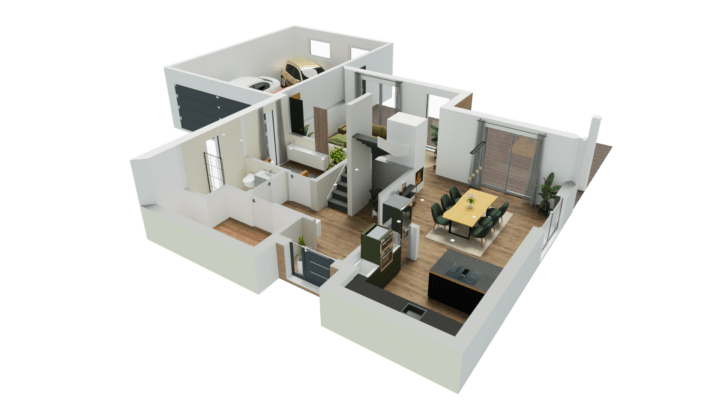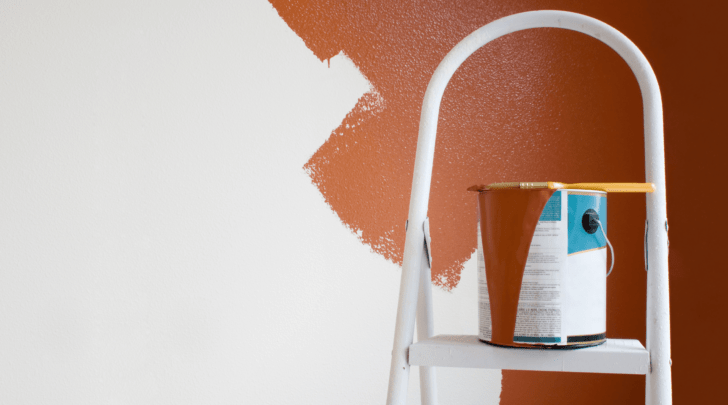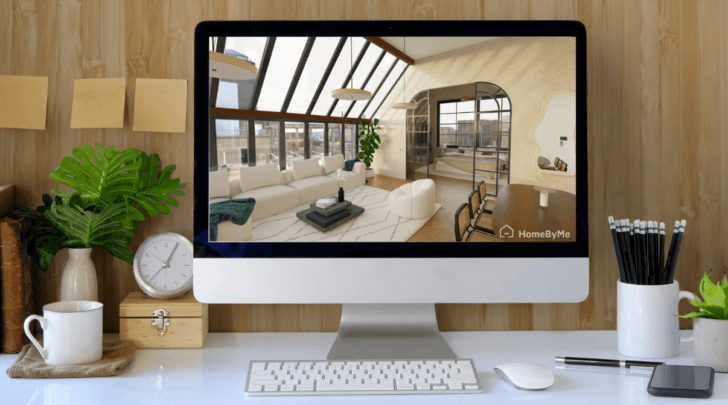Interior Designer vs Decorator: Which Career Path is Right for You?

High-speed & Pro
Intuitive to use with 0 Learning Curve
Complete with Branded & Generic Furniture
Discover key differences between interior designer versus decorator to see which career suits your style and skills best.
Are you contemplating a career in the world of interiors but feel uncertain about the differences between interior designer vs decorator? This is a common source of confusion as both terms are often used in similar contexts. However, it’s crucial to understand that they are two distinct roles requiring very different responsibilities and qualifications.
Interior designers blend artistic vision with technical expertise to create functional, cohesive spaces that meet both client needs and regulatory standards. On the other hand, interior decorators specialize in refining aesthetics, focusing on furnishings and decor to enhance the visual appeal of interiors.
Whether you’re drawn to the technical aspects of space planning or the artistic flair of decorating, understanding the distinctions between these professions is important in mapping out your professional path.
Below, we explore the roles, responsibilities, educational paths, and opportunities relevant to aspiring interior designers and decorators.
Let’s dive in!
Understanding Interior Design
The Role of Interior Designers
Interior designers are experts in creating functional, safe, and aesthetically pleasing environments. Their work spans residential, commercial, and industrial projects, requiring a blend of creativity and technical knowledge. Key responsibilities of an interior designer include:
- Space Planning: Optimizing the layout to ensure functionality and flow.
- Safety and Compliance: Ensuring designs meet building codes and safety regulations.
- Material Selection: Choosing appropriate materials and finishes.
- Collaboration: Working with architects, builders, and clients to bring visions to life.
- Project Management: Overseeing the entire design process from conception to completion.
Educational and Professional Requirements
Formal education and training are essential to becoming an interior designer. Most interior designers hold a bachelor’s degree in interior design or a related field. Coursework typically includes:
- Design Principles: Fundamentals of design, color theory, and spatial relationships.
- Computer-Aided Design (CAD): Proficiency in design software like HomeByMe, AutoCAD or SketchUp.
- Building Systems: Understanding of electrical, plumbing, and HVAC systems.
- Ethics and Business Practices: Professional conduct and management skills.
Many regions also require interior designers to be licensed or certified, which often involves passing the National Council for Interior Design Qualification (NCIDQ) exam.
Skills and Qualities
Successful interior designers possess a blend of creative and analytical skills, including:
- Creativity and Innovation: Ability to conceptualize unique and functional designs.
- Technical Proficiency: Skilled in CAD software and other design tools.
- Communication: Excellent verbal and written communication for client interactions and presentations.
- Attention to Detail: Precision in every aspect of design and execution.
- Problem-Solving: Ability to address challenges and find practical solutions.

Exploring Interior Decoration
The Role of an Interior Decorator
An interior decorator focuses on enhancing the aesthetics of a space. So their work is more about improving the appearance rather than making structural changes. Key responsibilities for interior decoration include:
- Color Schemes: Choosing and coordinating colors to create desired atmospheres.
- Furniture Selection: Picking furniture that complements the design style and meets functional needs.
- Accessories and Artwork: Selecting decorative items, textiles, and art pieces to enhance the space.
- Space Styling: Arranging decor to create harmonious and visually appealing environments.
Educational and Professional Pathways
While formal education can be beneficial, it is not mandatory to become an interior decorator. Many decorators start with a strong passion for design and develop their skills through experience and self-study. Relevant coursework might include:
- Color Theory: Understanding the impact of colors and how to combine them effectively.
- Design Styles: Knowledge of various design styles and their historical contexts.
- Textiles and Fabrics: Familiarity with different types of fabrics and their uses.
- Space Planning: Basic principles of arranging furniture and decor.
Certification programs, such as those offered by the Certified Interior Decorators International (C.I.D.), can enhance credibility and professional opportunities.
Skills and Qualities
Key skills for interior decorators include:
- Creativity and Vision: Ability to imagine and create beautiful spaces.
- Trend Awareness: Keeping up with the latest design trends and styles.
- Interpersonal Skills: Building strong relationships with clients and understanding their preferences.
- Detail-Oriented: Ensuring every element of the design is cohesive and well-executed.
- Budget Management: Ability to work within financial constraints to achieve desired results.
Discover HomeByMe 3D Design Software
Create a free account and start your project!
Key Differences Overview: Interior Designer vs Decorator
Scope of Work for Interior Designer vs Decorator:
- Interior Designers: Involves structural changes, space planning, and compliance with building codes. Interior designers often collaborate with architects and contractors.
- Interior Decorators: Focuses on the aesthetic enhancement of existing spaces without altering the structure. Decorators primarily deal with furniture, colors, and accessories.
Educational Requirements
- Interior Design: Typically requires a bachelor’s degree in interior design and may require licensure.
- Interior Decorator: Formal education is less critical; a strong design sense and relevant experience can suffice.
Technical Skills
- Interior Design: Proficiency in CAD and other design software is essential. Designers must understand building systems and construction methods.
- Interior Decorator: Emphasizes creative skills and an eye for detail rather than technical knowledge.
Client Interaction
- Interior Design: Involves extensive client interaction throughout the project, from initial consultation to final walkthrough.
- Interior Decorator: Often involves shorter project timelines with a focus on specific aesthetic elements.
Getting Started in Interior Design
Education and Training
Pursuing a degree in interior design is the first step. Look for accredited programs that offer comprehensive coursework and opportunities for hands-on experience. Internships and apprenticeships can provide valuable real-world exposure.
Building a Portfolio
A strong portfolio showcasing your design projects is crucial for attracting clients and employers. Include a variety of projects to demonstrate your versatility and skills.
Networking and Professional Development
Join professional organizations such as the American Society of Interior Designers (ASID) or the International Interior Design Association (IIDA) to connect with peers, attend industry events, and stay updated on trends and best practices.

Starting a Career as an Interior Decorator
Developing Your Skills
While formal education is optional, taking courses in design principles, color theory, and textiles can be beneficial as an interior decorator. Practice your skills by redesigning your own space or offering to help friends and family.
Creating a Portfolio
Like interior designers, decorators need a portfolio to showcase their work. Include before-and-after photos, mood boards, and client testimonials to highlight your abilities.
Marketing Yourself
Build an online presence through a professional website and social media profiles. Share your work, design tips, and engage with potential clients to build your reputation and attract business.
Leveraging Technology: Free Interior Decorator Software
The Role of Software in Interior Design and Decoration
Modern technology has revolutionized the way interior designers and decorators work. Free interior decorator software tools like HomeByMe can help visualize designs, create detailed plans, and communicate ideas to clients more effectively than ever before.
Using HomeByMe for Interior Decoration
HomeByMe is a free interior decorator software that allows users to create realistic, 3D models of decor or design concepts. Here’s how it can benefit your career:
- Visualization: Easily create and modify mockups, helping clients visualize the final result.
- Efficiency: Save time with ready-made templates and furniture options.
- Collaboration: Share your designs with clients and get real-time feedback.
- Skill Development: Experiment with different design styles and layouts to enhance your skills.
Getting Started with HomeByMe
- Sign Up: Create a free account on the HomeByMe website.
- Explore: Familiarize yourself with the interface and tools available.
- Design: Start creating your first project by selecting a room layout and adding furniture and decor.
- Share: Use the share function to present your design to clients or include it in your portfolio.
Whether you’re changing careers or just starting out, understanding these differences will help you make an informed decision and set you on the path to success in the vibrant world of interior design and decoration.
Discover also :
You may also like...
Discover how HomeByMe is a complete turnkey tool for your projects.
High-speed & Pro
Intuitive to use with 0 Learning Curve
Complete with Branded & Generic Furniture
Which Career Path is Right for You?




